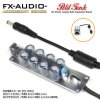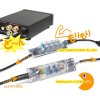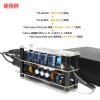Sorry for going off topic, but you seemed interested in improving the functionality of the DA-8s, my bad. Sometimes going off topic can bring more information.
Vanedersteen Model 2CE were definitely on the upper end of "Mid-Fi" back in the day. At approximately $1400 in the 90's. That wasn't an inexpensive speaker by any means. I highly doubt that the power brick was at fault for "blowing up". I would suspect that some of the internal capacitors (most likely electrolytic) have gone past their life expectancy. This could easily cause unwanted voltage to seep into the brick. Just so you know, one of the most famous Electrolytic capacitor companies in the world, Nichicon advise and put a production date on their parts and recommend that regardless of use, 10 years is the maximum lifetime before they start to break down just sitting on a shelf waiting to be sold. They can leak, they can explode, or they can short circuit. You'll most likely find them in the woofer section of the crossover, but just as easily they can be in the mids and in the tweeter network. It's a cost cutting measure. I would take a meter to the speaker to check the impedance first of the speakers as a whole, then I would take it apart and use an LCR meter to measure the capacitance of each capacitor which requires removal of each component, do this one at a time so you don't wind up with a mess of parts on the floor. Class-D amplifiers in general are very sensitive to reverse inputs of any sort, or small leaks of foreign voltage that can somehow come across the signal cables.
Power bricks are fairly robustly built. Upping the amperage can be a good thing but you can alternately overload the input capability of the chipset on the amplifier. You are in that horrible position of trying to help revive an older speaker that simply isn't designed for use with Class-D amplification. I hate to be the bearer of bad news, but I think that this isn't going to sort things out for you. I am suspicious of the speakers themselves first, especially the crossover network. Something probably leaked or failed. The little NFJ power filters use capacitors with parts that protect against the weaknesses of Class-D topology. Also the older generation of speakers were designed to be a lot looser in their pistonic movement. They had low damping factor in mind. Rotel amplifiers from that era had something like 180 for damping factor which is the ability for the amplifier to control the cones movement. Today's Class D amplifiers easily double that number which may seem good but it requires a total rethink of how to design a loudspeaker. The Vandersteens were a sensitive speaker of around 90db/watt. Today's speakers are around 87db/watt. Those 3decibles are the same to the amplifier as outputting double the sound just to play at the same output volume. For the human ear to hear something to be twice as loud, you need a 10db increase, or in this case 100db. 100db is literally deafening in a moderately sized living room.
I'm sorry Dougey, there are no easy answers to solve your problem. There's a reason why I have multiple Class-D amplifiers, and 2 valve amplifiers. Valve amplifiers have little to no damping factor. In fact my most powerful one has a damping factor of 8. It can drive a modern speaker without issues because I spent over 3k in modifying the amplifier to play as clean and with as much authority as I could get out of the amplifier. My smaller amplifier is capable of 5watts per channel, but that is tube power so it's actually able to play louder than my neighbours would like. And it's time for me to replace many of the electrolytic capacitors inside that amplifier.
I'm sorry to say this but I think your speakers need some surgery. Alternatively buy some ultra cheap current day speakers for less than $100 bucks and see if the problem persists. If it doesn't, which I suspect it won't, then you have your culprit. The bricks have internal capacitors and also inductors or coils which can literally die if the protective capacitor fails.
I think you've found yourself in that generational gap where amplifier technology and loudspeaker technology no longer matches. In Japan, there are a tonne, a literal tonne of used, good or great old transistor based amplifiers being sold at used electronics stores everywhere as the technology simply doesn't work with modern speakers well. The older speakers can work, but not to their optimum.
I'm sorry. I would try cheap speakers and pay around $100 to see if the same issue arises, if not replace the speakers or repair them. Expect to spend time and money to repair the old speakers. If indeed it's solved by the brick that you ordered then that's great! One word of caution would be to keep a close eye on it, hold it to see how much heat it's accumulating. Luke warm is ok, anything above that is not. Also lookout for deformation from heat.
If all else fails, replace everything to 2021 equipment. I have a pair of speakers from 1995 that are still absolutely fine shockingly. I opened everything up and found out that every single component still measured to spec, and nothing was leaking or expanding (electrolytic capacitors sometimes expand and blow up and ooze out their chemicals, not fun as it's caustic stuff).
Happy hunting. And sorry for going so far off topic. But going off topic was necessary for you to get to the bottom of this problem you had. This is what forums are for, to help others. This is not Twitter, or Facebook. Helping is a human thing. I don't know everything, but I know enough to get by after 29 years in the Hi-Fi industry. And yes, I sold Vandersteen speakers back in the day. I liked them personally!
SORRY THIS WAS SO LONG! I hope you have gained an understanding of what you are likely experiencing. I had an ICEpower TEAC fail on me and it would make ticking sounds above a certain level. It turned out my phonostage had semi-failed and was backfeeding 12Volts into the RCA's intermittently. The same phonostage connected to one of my tube amps made no issue of this backfeed. Class-D is sensitive. No amount of protective circuitry would have saved that amplifier. Fortunately I was able to sell it at 1/3rd the purchase price to the used electronics store as "Junk parts" and it was gone the next week, someone had bought it! The whole thing was fried internally!
Wish you luck in your endeavor. I'm sure you'll figure out a solution.
Cheers.




